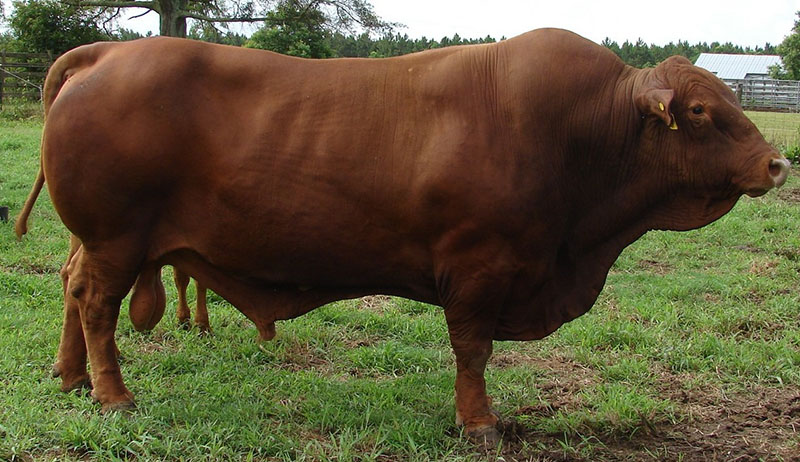Senepol Cattle
Genetic History In the 1800s N'Dama Cattle were imported to the Caribbean Island of St. Croix from Senegal, West Africa. By 1889,
Henry C. Nelthropp's Grenard Estates was one of the largest N'Dama breeders with over
250 head which he maintained as purebreds. Nelthropp's son, Bromley, wanted to develop
a strain of cattle that would combine the traits needed for good productions in the
tropical Virgin Island environment. In 1918, while visiting the island of Trinidad,
Bromley purchased a Red Poll bull to improve the milking ability, fertility and remove
the horns of the N'Dama.
imported to the Caribbean Island of St. Croix from Senegal, West Africa. By 1889,
Henry C. Nelthropp's Grenard Estates was one of the largest N'Dama breeders with over
250 head which he maintained as purebreds. Nelthropp's son, Bromley, wanted to develop
a strain of cattle that would combine the traits needed for good productions in the
tropical Virgin Island environment. In 1918, while visiting the island of Trinidad,
Bromley purchased a Red Poll bull to improve the milking ability, fertility and remove
the horns of the N'Dama.
 That bull and other Red Poll genetics were added over the next several years as Nelthropp
selected for: 1) early maturity and maternal efficiency, 2) no horns and solid red
color, 3) definite heat tolerance, and 4) gentle disposition. By the mid forties the
desired genetic combination of Red Poll and N'Dama was achieved and the Senepol breed
has been bred as fullblood ever since. The Nelthropp herd was dispersed to local breeders
and the Senepol breed grew into four primary island herds. Ward Cannaday and Fritz
E. Lawaetz maintained genetic records and eventually trademarked the Senepol name
in 1954. Having established a herd book, the breed adopted an on-farm performance
testing program through the USDA and the College of the Virgin Islands Extension Service
in 1976. In 1977 the first plane load of cattle left for the U.S. mainland; 17 years
later the Senepol influence has spread across the southern United States.
That bull and other Red Poll genetics were added over the next several years as Nelthropp
selected for: 1) early maturity and maternal efficiency, 2) no horns and solid red
color, 3) definite heat tolerance, and 4) gentle disposition. By the mid forties the
desired genetic combination of Red Poll and N'Dama was achieved and the Senepol breed
has been bred as fullblood ever since. The Nelthropp herd was dispersed to local breeders
and the Senepol breed grew into four primary island herds. Ward Cannaday and Fritz
E. Lawaetz maintained genetic records and eventually trademarked the Senepol name
in 1954. Having established a herd book, the breed adopted an on-farm performance
testing program through the USDA and the College of the Virgin Islands Extension Service
in 1976. In 1977 the first plane load of cattle left for the U.S. mainland; 17 years
later the Senepol influence has spread across the southern United States.
Breed Development
The isolation sheltered the cattle from the fads and fancies that have assaulted the purebred seedstock industry. Nor were they participants in the frame race. While other breeds made giant leaps in one direction, only to turn and make equally large strides in the opposite direction, the Senepol made a series of small, multiple-trait steps toward animals whose production met the demand of their breeders. St. Croix provided a unique situation where ranchers practice selection for the traits they desired and mother nature provided natural selection for cattle that could produce at superior levels under the harsh St. Croix environment.
 Until Senepol cattle came stateside in 1977, there was a very limited seedstock market.
The purpose of the cattle was to provide native beef for the island population of
St. Croix; only the progeny from top females ever went back into the herd for replacements.
To this day, there is still not even a "Stockyard" on St. Croix, the cattle were destined
to become seedstock or go to a butcher shop. This limited market got the "heads cut
off" of average and below average cattle and allowed the breed to be built on the
cattle that worked and had an ancestral history of cattle that worked.
Until Senepol cattle came stateside in 1977, there was a very limited seedstock market.
The purpose of the cattle was to provide native beef for the island population of
St. Croix; only the progeny from top females ever went back into the herd for replacements.
To this day, there is still not even a "Stockyard" on St. Croix, the cattle were destined
to become seedstock or go to a butcher shop. This limited market got the "heads cut
off" of average and below average cattle and allowed the breed to be built on the
cattle that worked and had an ancestral history of cattle that worked.
The cumulative St. Croix herd is closed, with no outside influence. The Senepol breed has had a limited genetic base and selection for superior performance has led to cattle that can take substantial levels of inbreeding. This accounts for the "true breeding" ability of the Senepol and the high degree of heterosis that they provide in crossbreeding systems.
References
Senepol Cattle Breeders Association, PO Box 1131; Wilmington, North Carolina 28402
